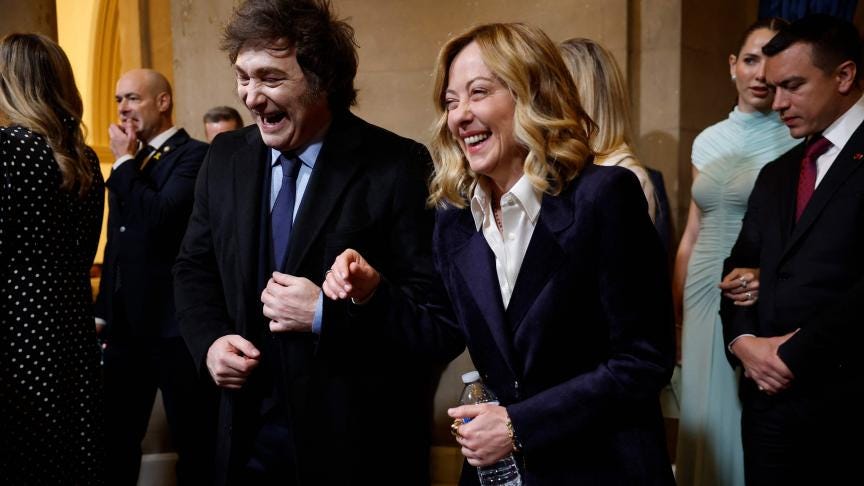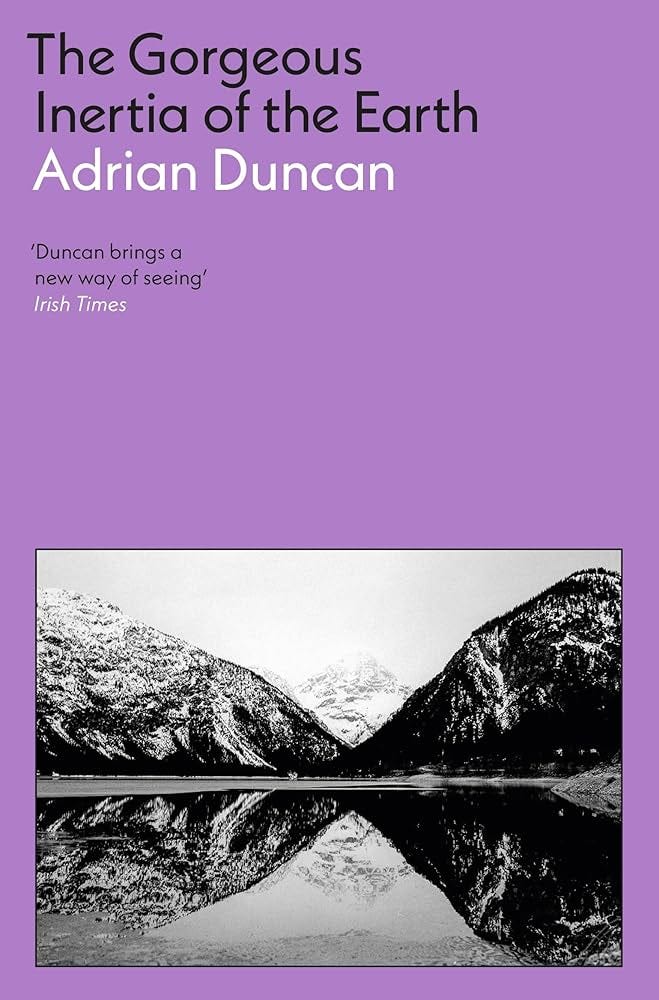The Italian media was almost entirely focused on Trump’s inauguration this week, as you’d imagine. And in case you missed the coverage, Giorgia Meloni was front and centre. In fact, the Italian Prime Minister was the only major EU leader to attend the event, and she certainly seemed to enjoy being pictured, beaming, alongside Javier Milei as she cheered the incoming administration. Despite the smiles, though, it was an oddly strained occasion. After all, on paper, Italy is particularly vulnerable to Trump’s ‘America first’ style protectionism. The country is the EU’s second largest exporter to the U.S, and it could be hit hard by sudden tariffs on goods like wine, olive oil and parmigiano reggiano. Clearly, Meloni is trying to charm the tyrant into mercy by playing up to American fantasies about Italy’s ‘great’ ancient history and conservative traditions. Musk, as I’ve previously reported, seems to have taken the bait. Trump, however, is a different man altogether. While Meloni is gambling that the President’s ego and imperial pride will prove more powerful than his business acumen, there’s just no predicting his next move. Then there’s the case of the EU. Meloni is assuming the Commission will be too disorganised and too weak to punish her for breaking rank and pursuing national interests over those of the bloc. This too is possible, but it’s by no means a given. Yesterday afternoon, Romano Prodi, Italy’s ex-PM, labelled Meloni’s strategy as a desperate effort to chase “short-term success,” which could yet have “long-term repercussions.” It would be hard to put it better. Whatever happens next, one thing is for certain: Italy is drifting further and further from European norms and closer and closer towards its own bilateral relationship with the U.S. These truly are uncharted waters.

But enough of international affairs. A lot’s been going on in domestic politics too which could have considerable bearing on those of us living in Italy. On Monday, the Constitutional Court announced that it is approving FIVE referendums to take place this spring, on a number of issues that will impact how we live, work and love. On the ballot, Italians will be asked to vote in favour or against a series of propositions including proposals to half the time required to apply for citizenship, to improve protections on labour dismissals, to increase compensation, to regulate fixed-term contracts and guarantee fairer public procurement processes. All of these issues are, of course, important, but I think the most relevant, and potentially transformative is the referendum on citizenship reform. As things stand, foreign residents need to live here for 10 years to begin the process. The new proposal, first put forward by the Partito Democratico, would reduce this to five years, in line with countries like the UK, Germany and France. This is going to be a key political faultline the next few months. The government will surely do all it can to discredit the proposal, while the left will face the tricky task of convincing the public that making an approximately 2.5 million residents eligible for Italian citizenship is both the right thing to do, and the best thing for the economy. To find out more about all five referendums, including the rejected vote on ‘differentiated autonomy’, check out this piece by WIRED Italy [ITA only I’m afraid].
Last week from January 17-21 Italy’s so-called “fashion month” kicked-off in Milan with the traditional inauguration of ‘Men's Fashion Week FW25’. It was a grey, damp instalment of the proceedings in more ways the one, with big brands like Gucci, Fendi, Moschino and DSquared2 entirely absent. There were, however, a few highlights worth drawing attention to and which, to my mind, redeemed the whole affair from the by now annual pessimistic reports of sclerosis, decadence and creative block. Take PRADA, who organised a fabulous runway show with abundant fake leather, or Armani who showcased bold looks with leopard print, fur and embroidered velvet. It was a good year for independent and emerging names too. Dhruv Kapoor’s sari and dhoti fused traditional Indian and European-urban clothing to great effect, and Simon Cracker’s punk upcycling was as exciting and thought provoking as ever. It was the street style I found most interesting this year, though: attendees were clad in monochrome, matching and neutral tones, and I was pleased to see British tweed on show in just about every outfit (something I can get on board with for sure). Check out the best of the runways here and PAUSE magazine’s coverage of the event(s) for day-by-day shots of the season’s menswear trends.
Arts & Culture: Gorgeous Inertia
Moving on to the darker side of Italian ‘glamour’: the photographer Stefano De Luigi has got a new monograph out called Televisiva which documents how Berlusconi’s media empire reshaped Italian TV in the 90s and 00s and with it the nation’s dominant aesthetics. In a certain sense this is well-trodden ground. I mean, we’ve certainly been here before. Erik Gandini’s film Videocracy did an excellent job of chronicalling the exploitation of the veline showgirls back in 2009; and more recently Paolo Sorrentino’s rather laboured film Loro foregrounded the patriarchal gaze in a manner that seemed to eschew moralising criticism in favour of well… perverse enjoyment. De Luigi’s photos exist in a hinterland between these two extremes. Shot in black and white over 15 years they document what Wallpaper magazine has described as a time of “grossly decadent game shows” in which “glamorous women, usually young and often not wearing much, [were] a frequent motif […] and older men appear[ed] mostly in suits, others in some form of fancy dress.” Today, it can often feel like we’re living in a world that’s darker than the 90s and 00s. But the fact remains, even in the age of Trump, these images still have the power to shock. Check out a selection here.
This week I had the great pleasure of reading an ENG language Italy-related novel which was, for once, more than just a glorified holiday diary. The Gorgeous Inertia of the Earth by the Irish writer Adrian Duncan is a serious psychological neo-existentialist drama set in northern Italy and told in two timelines, ten years apart. The first timeline is set in the Alps, during a cold winter, when our protagonist John falls in love with an Italian sculptor named Bernadette. The second timeline takes place ten years later, when John, having moved on with his life, returns to Italy on a trip to Bologna and, over the course of a single day, feels the boundaries between past, present and future shift as he’s forced to navigate the implications of a repressed trauma. I’ve no doubt that readers of this newsletter will appreciate the evocative chiaroscuro descriptions of Bologna’s porticos and parks. But this is also a profound investigation of the human psyche, and the strange unconscious relations we can make between sex and death, love and grief. Thanks again to Tuskar Rock publishers for the free copy. This one’s out on 30 January and you can pre-order it here.
Recipe of the week: Strangozzi alla Spoletina
I’ve just got back from a short jaunt in Umbria where I was taking advantage of the bassa stagione to pay a quick visit to a few cities I’d somehow never gotten round to: Assisi and Orvieto. I was there for the art, yes, but also, as ever, for the food; for the pork, sausage, game and truffle in particular. These things are all, naturally, delicious. But what I most enjoyed was actually a humble plate of strangozzi with tomato, garlic and parsley sauce which I ate sprinkled with some pecorino in a small osteria near Spoleto. This is one of the region’s typical dishes. Umbria’s answer – basically – to the better-known Tuscan pici. The accompanying sugo might look like your usual pasta al pomodoro but, as ever, proportion-wise, taste-wise, the dish has its own, subtle flavour profile that sits intriguingly somewhere between a carratiera, and sugo all’aglione. Gorgeous. I’m planning to recreate the flavours of the trip in my home kitchen this weekend to cheer up these dreary winter evenings. So, if you’re interested in a bit of culinary armchair travel, check out Georgette Jupe’s travel guide to Spoleto over at Italy Magazine and head over the excellent ristorante del mercato’s website for their instructions on how to prep-up an authentic, traditional plate of strangozzi alla Spoletina. Here’s the link.
I’m Jamie Mackay, a UK-born, Italy-based writer, working at the interfaces of journalism, criticism, poetry, fiction, philosophy, travelogue and cultural-history. I set up ‘The Week in Italy’ to make a space to share a regular overview of the debates and dilemmas, innovations and crises that sometimes pass under the radar of our overcrowded news feeds, to explore politics, current affairs, books, arts and food. If you’re a regular reader, and you enjoy these updates, I hope you’ll consider becoming a supporter for EUR 5.00 per month. I like to think of it as a weekly catch-up chat over an espresso. Alternatively, if you’d like to send a one-off something, you can do so via PayPal using this link. Grazie!






